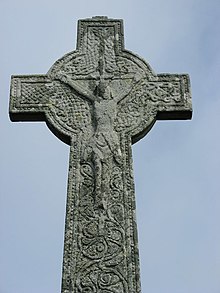Oronsay Priory
The Priory
The priory continued in operation until at least 1560, the year of the Scottish Reformation, with the last known prior, Robert Lamont, having been elected in 1555. The lands and property of the priory were given in commendam to Maol Choluim MacDubhthaich in 1561. They were later given to the Bishop of the Isles by King James VI of Scotland after his ascendancy to the throne in 1583. Restoration work and excavation and recording were carried out in 1883 by the architect William de B M Galloway and again in 1927 by the Ministry of Works and are visible today, together with the High Cross, as a scheduled ancient monument.
Additional burial enclosures were added as late as the 19th century.
High Cross
The High Cross stands about four metres east of the ruins of the monastery church and rises from a four-tiered foundation. From the inscription it can be seen that the cross recalls the death of the prior Colin, who presided over the Oronsay monastery and probably dates from the year 1510, Colin's dying year. On the westward side of the cross are scenes of the crucifixion of Jesus and on the east side are foliage motifs.


See also
Bibliography
- Cowan, Ian B. & Easson, David E., Medieval Religious Houses: Scotland With an Appendix on the Houses in the Isle of Man, Second Edition, (London, 1976), p. 76
- Watt, D.E.R. & Shead, N.F. (eds.), The Heads of Religious Houses in Scotland from the 12th to the 16th Centuries, The Scottish Records Society, New Series, Volume 24, (Edinburgh, 2001), pp. 165–7
References
- ^ "Oronsay Priory". Britain Express.
- ^ "Oronsay Priory". Am Baile – Highland History and Culture. Retrieved 6 December 2021.
- ^ Historic Environment Scotland. "Oronsay Priory and Cross (SM287)". Retrieved 25 February 2019.
- ^ "Dictionary of Scottish Architects - DSA Architect Biography Report (October 11, 2019, 5:47 pm)". www.scottisharchitects.org.uk. Retrieved 11 October 2019.
External links
![]() Media related to Oronsay Priory at Wikimedia Commons
Media related to Oronsay Priory at Wikimedia Commons